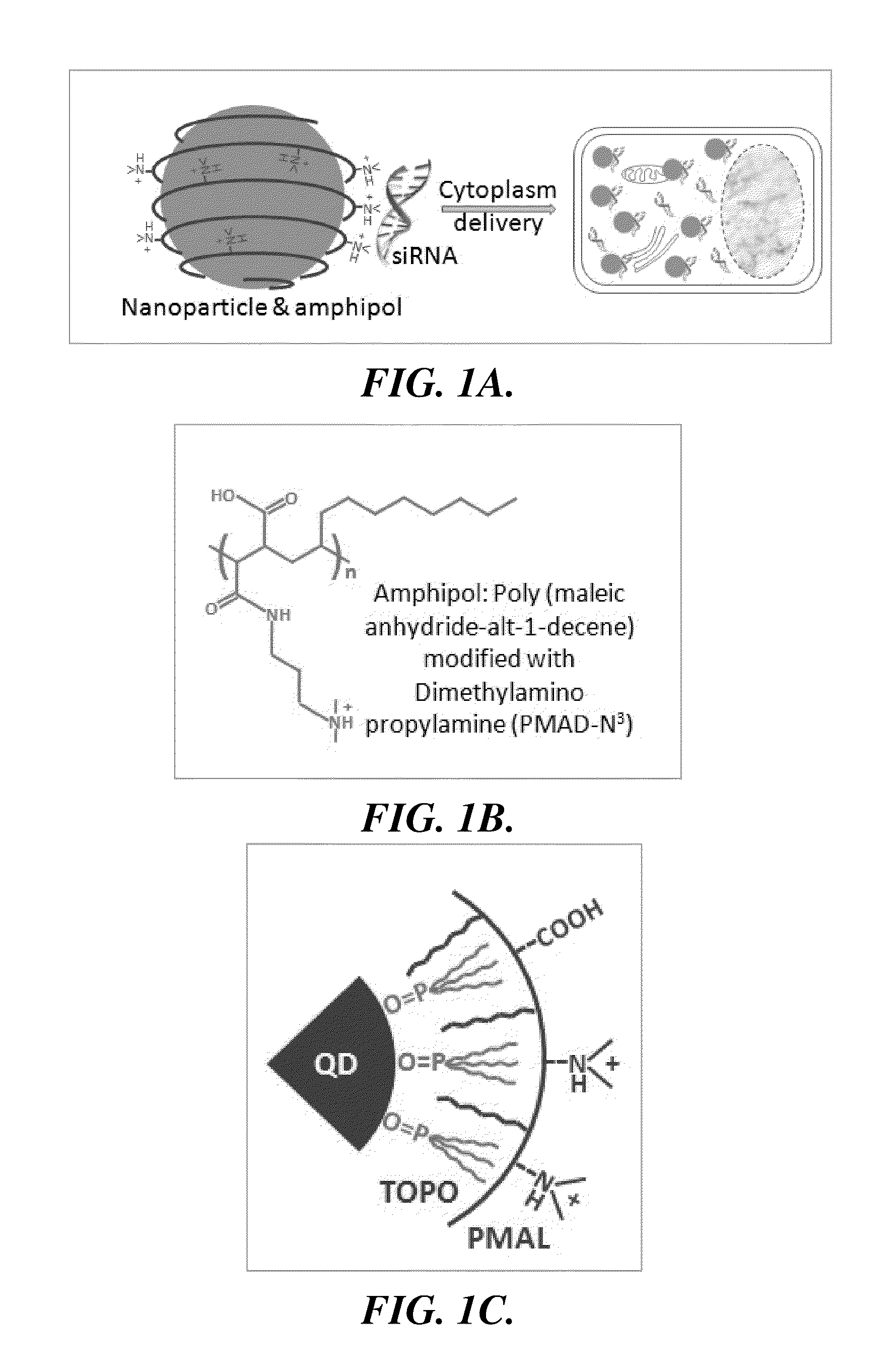Nanoparticle-amphipol complexes for nucleic acid intracellular delivery and imaging
a nucleic acid and amphipol technology, applied in the field of nanoparticle-amphipol complexes for nucleic acid intracellular delivery and imaging, can solve the problems of lack of intrinsic signal for long-term and real-time imaging of sirna transport and release, low delivery efficiency, and preventing long-term tracking of sirna-carrier complexes. achieve strong proton absorption capability, facilitate sirna release inside cells, and reduce electrostatic binding
- Summary
- Abstract
- Description
- Claims
- Application Information
AI Technical Summary
Benefits of technology
Problems solved by technology
Method used
Image
Examples
example
Example 1
The Preparation and Characterization of Representative Nanoparticle-Amphipol Complexes: Quantum Dot-Amphipol Complexes
[0095]In this example, the preparation and characterization of representative nanoparticle-amphipol complexes, quantum dot-amphipol complexes (QD-PMAL), are described.
[0096]Materials and Methods. Unless specified, chemicals were purchased from Sigma-Aldrich (St. Louis, Mo.) and used without further purification. PMAL was purchased from Anatrace Inc. (Maumee, Ohio). siRNA targeting Her-2, FITC labeled siRNA targeting Her-2, and the control sequence were purchased from Ambion (Austin, Tex.). A UV-2450 spectrophotometer (Shimadzu, Columbia, Md.) and a Fluoromax4 fluorometer (Horiba Jobin Yvon, Edison, N.J.) were used to characterize the absorption and emission spectra of QDs. A tabletop ultracentrifuge (Beckman TL120) was used for nanoparticle purification and isolation. The dry and hydrodynamic radii of QDs were measured on a CM100 transmission electron micros...
example 2
The Preparation and Characterization of Representative Nanoparticle-Amphipol Complexes: Magnetic Nanoparticle-Amphipol Complexes
[0104]In this example, the preparation and characterization of representative nanoparticle-amphipol complexes, magnetic nanoparticle-amphipol (MNP-PMAL) complexes, are described.
[0105]Materials and Methods. Unless specified, chemicals were purchased from Sigma-Aldrich (St. Louis, Mo.) and used without further purification. PMAL was purchased from Anatrace Inc. (Maumee, Ohio). SiRNA targeting eGFP, FITC labeled siRNA, and a control scrambled sequence were purchased from Ambion (Austin, Tex.). Rare earth magnets were obtained from Applied Magnets (Plano, Tex.). Highly uniform MNPs with sizes ranging from 5 nm to 50 nm were a gift from Ocean Nanotech LLC (Springdale, Ark.). The MNP molar concentration was calculated from measured Fe concentration (Mykhaylyk, O.; Antequera, Y. S.; Vlaskou, D.; Plank, C. Nat. Protocols 2007, 2, 2391-2411) using the conversion ta...
PUM
| Property | Measurement | Unit |
|---|---|---|
| diameter | aaaaa | aaaaa |
| hydrodynamic diameter | aaaaa | aaaaa |
| hydrodynamic diameter | aaaaa | aaaaa |
Abstract
Description
Claims
Application Information
 Login to View More
Login to View More - R&D
- Intellectual Property
- Life Sciences
- Materials
- Tech Scout
- Unparalleled Data Quality
- Higher Quality Content
- 60% Fewer Hallucinations
Browse by: Latest US Patents, China's latest patents, Technical Efficacy Thesaurus, Application Domain, Technology Topic, Popular Technical Reports.
© 2025 PatSnap. All rights reserved.Legal|Privacy policy|Modern Slavery Act Transparency Statement|Sitemap|About US| Contact US: help@patsnap.com



